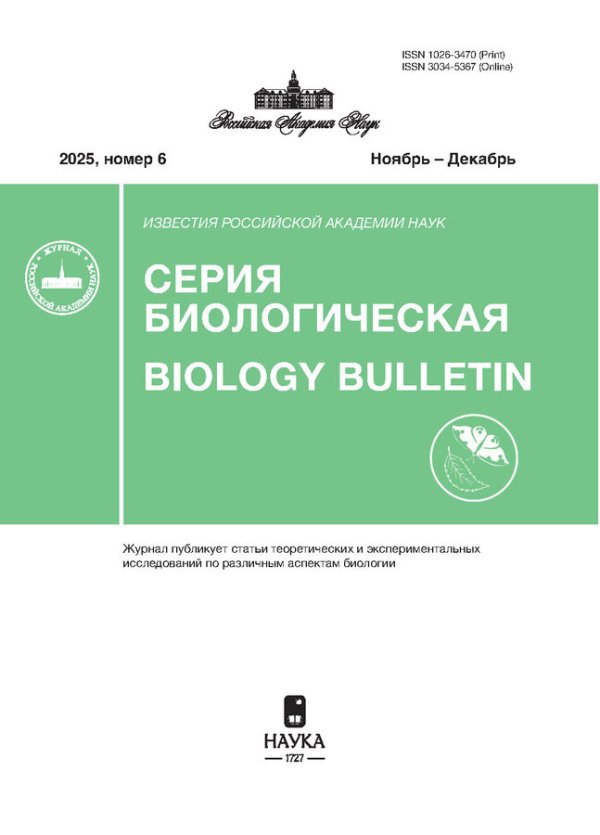Physiological and Biochemical Characteristics, and Biotechnological Potential of Hydrolitic Haloalkalitolerant Bacteria of Soda Sludge Storage
- Authors: Maksimova Y.G.1,2, Shilova A.V.1, Egorova V.V.1, Shchetko V.A.3, Maksimov A.Y.1,2
-
Affiliations:
- Institute of Ecology and Genetics of Microorganisms of the Ural Branch of the Russian Academy of Sciences
- Perm State University
- Institute of Microbiology of the National Academy of Sciences
- Issue: No 2 (2023)
- Pages: 149-159
- Section: МИКРОБИОЛОГИЯ
- URL: https://journals.rcsi.science/1026-3470/article/view/135513
- DOI: https://doi.org/10.31857/S1026347022700068
- EDN: https://elibrary.ru/HANYNK
- ID: 135513
Cite item
Full Text
Abstract
Peculiarities of manifestation of hydrolytic activity of haloalkalitolerant bacteria Pseudomonas peli 3-T, Microbacterium kitamiense 16-DB, and Bacillus aequororis 5-DB, isolated from the soil of the territory of the soda sludge storage and the soda sludge of the functioning sludge reservoir of Berezniki Soda Plant (Perm Territory, Russia) were studied. It was shown that the maximum activity of extracellular lipases and amylases of the three studied bacteria were manifested at pH 11 and a high concentration of sodium chloride (50–200 g/L). Cultivation of P. peli 3-T on a mineral medium with 0.5% glycerol (source of carbon) and 0.03% urea (source of nitrogen) makes it possible to obtain biomass (6.9 g/L) and activity of extracellular lipase (1.26 U/L) and lipase associated with cells (3.02 U/mg dry cells) with a high economic ratio of substrate consumption (138%). The efficiency of immobilization of P. peli 3-T and B. aequororis 5-DB cells for use in lipid and starch biotransformation was shown. P. peli 3-T cells immobilized by adsorption on kaolin and incorporated into the structure of barium alginate and agarose gels retained from 40.4 to 63.8% of the cell lipase activity in suspension. B. aequororis 5-DB cells immobilized by adsorption on kaolin retained 42.5% of lipase and 90.7% of amylase activity as compared to the initial ones. At the same time, the activities of the P. peli 3-T and B. aequororis 5-DB enzymes were preserved during 6 consecutive reactions. The amylase activity of immobilized M. kitamiense 16-DB cells by adsorption on kaolin and chitosan decreased to 2.7–3.5% of the initial value and was completely inhibited upon immobilization by cell’s entrapment into barium alginate gels or agarose gels.
About the authors
Yu. G. Maksimova
Institute of Ecology and Genetics of Microorganisms of the Ural Branch of the Russian Academy of Sciences; Perm State University
Author for correspondence.
Email: maks@iegm.ru
Russia, 614081, Perm, Golev str., 13; Russia, 614990, Perm, Bukirev str., 15
A. V. Shilova
Institute of Ecology and Genetics of Microorganisms of the Ural Branch of the Russian Academy of Sciences
Email: maks@iegm.ru
Russia, 614081, Perm, Golev str., 13
V. V. Egorova
Institute of Ecology and Genetics of Microorganisms of the Ural Branch of the Russian Academy of Sciences
Email: maks@iegm.ru
Russia, 614081, Perm, Golev str., 13
V. A. Shchetko
Institute of Microbiology of the National Academy of Sciences
Email: maks@iegm.ru
Belarus, 220141, Minsk, Kuprevich str., 2
A. Yu. Maksimov
Institute of Ecology and Genetics of Microorganisms of the Ural Branch of the Russian Academy of Sciences; Perm State University
Email: maks@iegm.ru
Russia, 614081, Perm, Golev str., 13; Russia, 614990, Perm, Bukirev str., 15
References
- Безбородов А.М., Загустина Н.А. Липазы в реакциях катализа в органическом синтезе (обзор) // Прикладная биохимия и микробиология. 2014. Т. 50. № 4. С. 347–373.
- Максимов А.Ю., Максимова Ю.Г., Кузнецова М.В., Олонцев В.Ф., Демаков В.А. Иммобилизация на углеродных сорбентах клеток штамма Rhodococcus ruber gt1, обладающего нитрилгидратазной активностью // Прикладная биохимия и микробиология. Т.43. № 2. 2007. С. 193–198.
- Шеламова С.А., Тырсин Ю.А. Индукция биосинтеза липаз микромицетом. Вестник ОГУ. 2012. № 1(137). С. 172–176.
- Шилова А.В., Максимов А.Ю., Максимова Ю.Г. Выделение и идентификация алкалотолерантных бактерий с гидролитической активностью из содового шламохранилища // Микробиология. 2021. Т. 90. № 2. С. 155–165.
- Akkaya B., Yenidunya A.F., Akkaya R. Production and immobilization of a novel thermoalkalophilic extracellular amylase from bacilli isolate // Int. J. Biol. Macromol. 2012. V. 50. P. 991–995.
- Amoah J., Ho S.-H., Hama S., Yoshida A., Nakanishi A., Hasunuma T., Ogino C., Kondo A. Converting oils high in phospholipids to biodiesel using immobilized Aspergillus oryzae whole-cell biocatalysts expressing Fusarium heterosporum lipase // Biochem. Eng. J. 2016. V. 105. P. 10–15.
- Arumugam A., Ponnusami V. Biodiesel production from Calophyllum inophyllum oil using lipase producing Rhizopus oryzae cells immobilized within reticulated foams // Renewable Energy. 2014. V. 64. P. 276–282.
- Bajaj A., Lohan P., Jha P.N., Mehrotra R. Biodiesel production through lipase catalyzed transesterification: An overview // J. Mol. Catal. B: Enzym. 2010. V. 62. P. 9–14.
- Bulow L., Mosbach K. The expression in E. coli of a polymeric gene coding for an esterase mimic catalyzing the hydrolysis of p-nitrophenyl esters // FEBS Lett. 1987. V. 210. P. 147–152.
- DasSarma S., DasSarma P. Halophiles and their enzymes: Negativity put to good use // Curr. Opin. Microbiol. 2015. V. 25. P. 120–126.
- Eş I., Vieira J.D.G., Amaral A.C. Principles, techniques, and applications of biocatalyst immobilization for industrial application // Appl. Microbiol. Biotechnol. 2015. V. 99. P. 2065–2082.
- Ferrarezi A.L., Ohe T.H.K., Borges J.P., Brito R.R., Siqueira M.R., Vendramini P.H., Quilles Jr.J.C., Nunes C. da C.C., Bonilla-Rodriguez G.O., Boscolo M., Da-Silva R., Gomes E. Production and characterization of lipases and immobilization of whole cell of the thermophilic Thermomucor indicae seudaticae N31 for transesterification reaction // J. Mol. Catal. B: Enzym. 2014. V. 107. P. 106–113.
- Fujinami S., Fujisawa M. Industrial applications of alkaliphiles and their enzymes – past, present and future // Environ. Technol. 2010. V. 31(8–9). P. 845–856.
- Gen Q., Wang Q., Chi Z.-M. Direct conversion of cassava starch into single cell oil by co-cultures of the oleaginous yeast Rhodosporidium toruloides and immobilized amylases-producing yeast Saccharomycopsis fibuligera // Renewable Energy. 2014. V. 62. P. 522–526.
- Grbavčić S.Ž., Dimitrijević–Branković S.I., Bezbradica D.I., Šiler–Marinković S.S., Knežević Z.D. Effect of fermentation conditions on lipase production by Candida utilis // J. Serb. Chem. Soc. 2007. V. 72(8–9). P. 757–765.
- Guldhe A., Singh P., Kumari S., Rawat I., Permaul K., Bux F. Biodiesel synthesis from microalgae using immobilized Aspergillus niger whole cell lipase biocatalyst // Renewable Energy. 2016. V. 85. P. 1002–1010.
- Gupta G.N., Srivastava S., Khare S.K., Prakash V. Extremophiles: an overview of microorganism from extreme environment // Int. J. Agriculture, Environment & Biotechnol. 2014. V. 7(2). P. 371–380.
- Hama S., Yamaji H., Fukumizu T., Numata T., Tamalampudi S., Kondo A., Noda H., Fukuda H. Biodiesel-fuel production in a packed-bed reactor using lipase-producing Rhizopus oryzae cells immobilized within biomass support particles // Biochem. Eng. J. 2007. V. 34. P. 273–278.
- Hemachander C., Bose N., Puvanakrishnan R. Whole cell immobilization of Ralstonia pickettii for lipase production // Process Biochem. 2001. V. 36. P. 629–633.
- Khanpanuek S., Lunprom S., Reungsang A., Salakkam A. Repeated-batch simultaneous saccharification and fermentation of cassava pulp for ethanol production using amylases and Saccharomyces cerevisiae immobilized on bacterial cellulose // Biochem. Eng. J. 2022. V. 177. 108258.
- Koda R., Numata T., Hama S., Tamalampudi S., Nakashima K., Tanaka T., Ogino C., Fukuda H., Kondo A. Ethanolysis of rapeseed oil to produce biodiesel fuel catalyzed by Fusarium heterosporum lipase-expressing fungus immobilized whole-cell biocatalysts // J. Mol. Catal. B: Enzym. 2010. V. 66. P. 101–104.
- Krulwich T.A., Liu J., Morino M., Fujisawa M., Ito M., Hicks D.B. Adaptive mechanisms of extreme alkaliphiles / In book: Extremophiles Handbook. Ed. K. Horikoshi. Springer, 2011. P. 119–139.
- Kumar S., Karan R., Kapoor S., Singh S.P., Khare S.K. Screening and isolation of halophilic bacteria producing industrially important enzymes // Brazil. J. Microbiol. 2012. V. 43(4). P. 1595–1603.
- Lόpez-Fernández J., Benaiges M.D., Valero F. Second- and third-generation biodiesel production with immobilised recombinant Rhizopus oryzae lipase: Influence of the support, substrate acidity and bioprocess scale-up // Biores. Technol. 2021. V. 334. 125233
- Mageswari A., Subramanian P., Chandrasekaran S., Sivashanmugam K., Babu S., Gothandam K.M. Optimization and immobilization of amylase obtained from halotolerant bacteria isolated from solar salterns // J. Genet. Eng. Biotechnol. 2012. V. 10. P. 201–208.
- Oda M., Kaieda M., Hama S., Yamaji H., Kondo A., Izumoto E., Fukuda H. Facilitatory effect of immobilized lipase-producing Rhizopus oryzae cells on acyl migration in biodiesel-fuel production // Biochem. Eng. J. 2005. V. 23. P. 45–51.
- Oliveira A.F., Bastos R.G., de la Torre L.G. Bacillus subtilis immobilization in alginate microfluidic-based microparticles aiming to improve lipase productivity // Biochem. Eng. J. 2019. V. 143. P. 110–120.
- Rakchai N., H-Kittikun A., Zimmermann W. The production of immobilized whole-cell lipase from Aspergillus nomius ST57 and the enhancement of the synthesis of fatty acid methyl esters using a two-step reaction // J. Mol. Catal. B: Enzym. 2016. V. 133. S128–S136.
- Sarethy I.P., Saxena Y., Kapoor A., Sharma M., Sharma S.K., Gupta V., Gupta S. Alkaliphilic bacteria: applications in industrial biotechnology // J. Ind. Microbiol. Biotechnol. 2011. V. 38. P. 769–790.
- Surendhiran D., Vijay M., Sirajunnisa A.R. Biodiesel production from marine microalga Chlorella salina using whole cell yeast immobilized on sugarcane bagasse // J. Environ. Chem. Eng. 2014. V. 2(3). P. 1294–1300.
- Tamalampudi S., Talukder M.R., Hama S., Numata T., Kondo A., Fukuda H. Enzymatic production of biodiesel from Jatropha oil: A comparative study of immobilized-whole cell and commercial lipases as a biocatalyst // Biochem. Eng. J. 2008. V. 39. P. 185–189.
- Taskin M., Ucar M.H., Unver Y., Kara A.A., Ozdemir M., Ortucu S. Lipase production with free and immobilized cells of cold-adapted yeast Rhodotorula glutinis HL25 // Biocatal. Agric. Biotechnol. 2016. V. 8. P. 97–103.
- Verma N.K., Raghav N. Comparative study of covalent and hydrophobic interactions for α-amylase immobilization on cellulose derivatives // Int. J. Biol. Macromol. 2021. V. 174. P. 134–143.
- Zaitsev S.Yu., Savina A.A., Zaitsev I.S. Biochemical aspects of lipase immobilization at polysaccharides for biotechnology // Adv. Colloid Interface Sci. 2019. V. 272. 102016.
- Zhang L.Y., Wei D.Z., Tong W.Y. Effective inducers for lipase production by Candida rugosa // Ann. Microbiol. 2003. V. 53(4). P. 499–504.
Supplementary files














